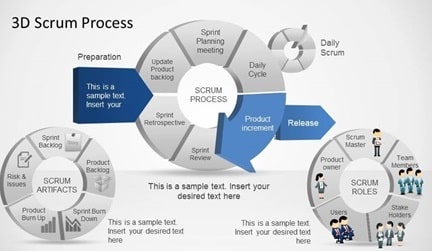Project Management for SEO and Digital Marketing
Project Management for SEO and Digital Marketing can Change the game, how? Let’s dig deep into it, to developing better understanding. Digital Marketing is an ever changing field, with hundreds of new trends, new approaches and new techniques being introduced ever. You need to keep pace in order to chasing the digital Marketing’s ever changing trends. Devising your strategies of project Management carefully, can prove to be a real game changer in the Digital World. Various techniques and methodologies are used for Project Management for SEO and Digital Marketing, Agile Scrum is one of the most effective methodologies.
What is Agile Scrum Methodology?
 Scrum can be referred as a framework for managing a process in an Agile way. In Agile technique tasks are divided into short phases of work coupled with frequent reassessment and adaptation of plans. In Scrum Methodology multiple small teams like Design and Development team, blogger outreach team, content creator’s team, etc. work to achieve a single goal in an intensive and interdependent way. Whenever some problem arises during work, every team member no matter it is design and development team, blogger outreach team or content creators contributes to solve the issue, making the task going smoothly.
Scrum can be referred as a framework for managing a process in an Agile way. In Agile technique tasks are divided into short phases of work coupled with frequent reassessment and adaptation of plans. In Scrum Methodology multiple small teams like Design and Development team, blogger outreach team, content creator’s team, etc. work to achieve a single goal in an intensive and interdependent way. Whenever some problem arises during work, every team member no matter it is design and development team, blogger outreach team or content creators contributes to solve the issue, making the task going smoothly.
Scrum needs well trained, specialized teams that are capable of independently handling the upcoming issues to achieving the goal in SEO and Digital Marketing. The teams in Scrum share common interests.
Components of Scrum
Scrum comprises of a Product Owner or Project manager, a Scrum Master and a Team. The Scrum Master’s job is to facilitate and support the team members to keep the work going. Scrum Master cannot be referred as a Boss, who traditionally provides directions or assign tasks to sub-ordinates. He could be called a Mentor who supports and facilitates the teams.
The Product Owner or Project Manager is responsible to set the goals to be achieved in specific time period. Product Owner or Manager creates a vision of the product. That vision reaches down to the team members through product backlog. Time to achieve a goal in Agile Scrum is called a Sprint. A Sprint is shorter in Agile Scrum ranging between two weeks to one month, as compared to other Project Management methodologies.
Team members are experts in their respective fields. They are free to choose, how they want to accomplish a specific task. Team members work collectively; meaning that whenever any of the team members faces any halts or problems in progressing during a Sprint, other team members come forward to help solve that problem. This approach of Agile Scrum achieves the desired goals set by the Product Owner effectively and efficiently.
Scrum Team’s roles can be elaborated through an example; the Product Owner will show them Final Destination where the team would have to reach, team members are independent to choose whatever routes they want to opt to reach the destination, and Scrum Master is there to provide support in case there are any impediments in the way.
Product owner is responsible to define and prioritize the tasks to be done. Furthermore, Scrum involves planning sessions for each task. The teams need to conduct daily meetings. Potential project risks and pitfalls are identified. Projects are executed in high intensity, brief and frequent work sessions.
How Scrum Methodology Works
Product is the primary element in Scrum Project management, around which the entire Scrum evolves. At the end of each Sprint the Scrum team is expected to design the product or system exactly comprising the features as is desired by the Product Owner or any other key stake holders.
Product backlog is the list of features or functionalities that needs to be incorporated in the Product or system. The product Owner is responsible to prioritize the features that need to be accomplished first. Product backlog might contain short descripts of functionalities or features of the product by users or potential customers’ prospective.
In project progress there are a series of sprints. Each sprint is no longer than two weeks or one month.
The Sprint planning meeting describes the desired outcome of the project. Here there is no set of entry criteria, validation criteria, ETVX or Task Definitions. Team members have complete autonomy to accomplish tasks, the way they desire. In meeting team members create a Sprint backlog – meaning that a list of the tasks they need to perform during that sprint is created. Each member finds out how many items each of the members can commit to.
Every day a Scrum Meeting is called. Product owner, Scrum Master and team members all must have to attend Daily Scrum Meeting. It’s a brief session of almost 15 minutes, in which issues are discussed, if there are any, team members share their progress of previous day, and what they are going to do that day. However, issues are not solved in the same meeting. Daily Scrum Meeting is a way of synchronizing the work of team members.
Sprint Burndown Charts and Release Burndown Charts are visual tools to keep track of the project’s performance. The Burndown Charts inform about the remaining work that was scheduled to be achieved in a specific Sprint. The Charts highlight any lag behinds of the teams in accomplishing the task on some specific deadline.
Sprint Review is conducted at the end of each sprint. In review teams present the overall functionality achieved in that sprint to the Product Owner. The Product Owner gives his/her feedback that’s very important for the sprint to be accomplished next. The product functionality might need to be changed or revised according to the feedback provided, or there might be addition of some more items in product backlog.
Sprint Retrospective is an important activity in Scrum project Management. Sprint Retrospective is conducted at the end of each sprint. Everyone including Product Owner, Scrum Master as well as Team Members attend the retrospective meeting. It’s crucial in identifying opportunities to improve the project in the forthcoming sprints.
Conclusion
An effective methodology of Project Management for SEO and Digital marketing can change the game. The Agile Scrum method of managing a Project is time effective; small divisions of work (Sprints) help achieve the defined functionalities efficiently. Team work adds value to the method by facing any impediments without wasting time or affecting the project’s progress. Sprints Reviews, Retrospectives and Feedbacks help identifying the problems as well opportunities in a timely manner that boost the Team’s performance to providing the finished product or System, featured exactly as is desired by the Client.
Author Bio: Shahzad Hassan Butt is an Inbound Marketing Methodology Evangelist. He is passionate about  Psychology, Marketing and Business Development. He loves to help individuals and businesses getting better use of technology for growth.
Psychology, Marketing and Business Development. He loves to help individuals and businesses getting better use of technology for growth.





Hi, Could you please guide me how to implement Agile Methodology in digital marketing. I just started a project for digital marketing. i dont have proper guidlines so please help me
Your post topic is very unique and good for the readers so i am really impress so carry on for more unique post because people will follow more your site. Thanks